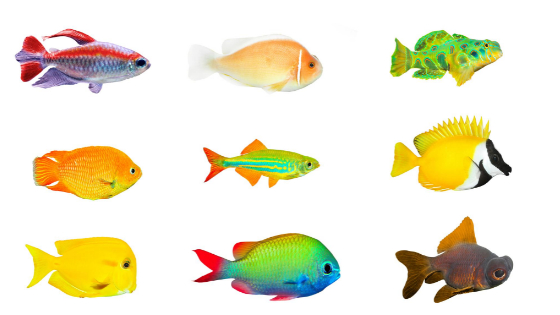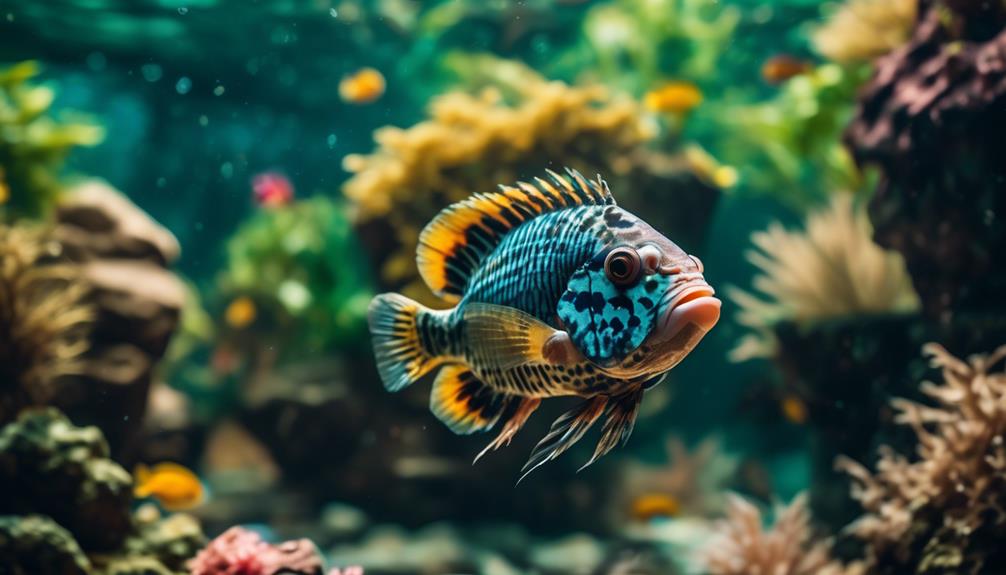
Are you curious about the enchanting colors and intriguing behaviors of Lake Tanganyika cichlids? Picture yourself observing the breathtaking display of a male Tropheus cichlid as it flaunts its vibrant red and yellow hues in a bid to attract a mate.
But there’s more to these cichlids than meets the eye. As you delve into the world of Lake Tanganyika cichlids, you’ll uncover a fascinating array of species, each with its own unique charm and breeding habits. From the Goby Cichlids to the Julidochromis, Cyprichromis, and Altolamprologus, the diversity of these fish is astounding.
But what secrets lie beneath the surface of Lake Tanganyika? And how can you recreate their natural habitat in your own aquarium? Join us on this captivating journey as we dive into the colorful world of Lake Tanganyika cichlids and uncover the wonders that await.
Key Takeaways
- Lake Tanganyika is home to a diverse array of cichlid species, with 98% of them being endemic to the lake.
- The Tropheus genus is the largest genus of Lake Tanganyika cichlids, but there are also other genuses such as Goby Cichlids, Neolamprologus, Julidochromis, Cyprichromis, and Altolamprologus.
- Lake Tanganyika cichlids are known for their aggression and should be housed separately or as breeding pairs.
- These cichlids exhibit a wide variety of colors and patterns, adding to the vibrant and colorful world of Lake Tanganyika.
Lake Tanganyika Cichlids: Endemic Beauties
Lake Tanganyika cichlids, with their vibrant colors and intricate patterns, are truly the epitome of endemic beauties. These stunning fish are known for their unique and eye-catching appearances, making them a favorite among aquarium enthusiasts.
With over 98% of Lake Tanganyika cichlids being endemic to the lake, each species has developed its own distinct coloration and markings. From the electric blues and yellows of the Tropheus genus to the striking black and white patterns of the Julidochromis, the diversity of colors and patterns in Lake Tanganyika cichlids is truly remarkable.
Whether you admire their bold and vibrant hues or appreciate their intricate and intricate patterns, these fish are sure to captivate and mesmerize anyone who sets eyes on them.
The Diverse Genus of Lake Tanganyika Cichlids

With their distinct colors and patterns, Lake Tanganyika cichlids showcase a diverse range of species within their genus. The Tropheus genus is the largest genus of Lake Tanganyika cichlids, but there are also other genuses such as Goby Cichlids, Neolamprologus, Julidochromis, Cyprichromis, and Altolamprologus.
Each genus contains multiple species, each with its own unique characteristics. These cichlids can vary greatly in size, shape, and behavior. Some species are known for their vibrant colors, while others have intricate patterns.
The diversity within the genus of Lake Tanganyika cichlids is a testament to the rich ecosystem of the lake and the evolutionary adaptations that have occurred over time. Whether you prefer bold and vibrant or subtle and intricate, there’s a Lake Tanganyika cichlid species to suit every aquarist’s taste.
Vibrant Colors and Patterns of Tanganyika Cichlids
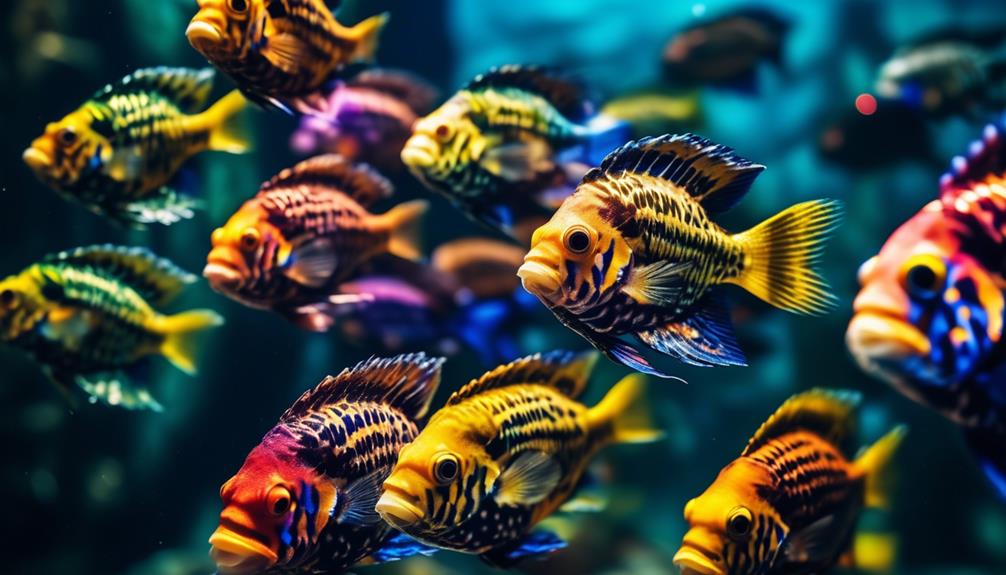
Tanganyika Cichlids mesmerize with their vibrant colors and intricate patterns, showcasing the true beauty of nature underwater. These fish come in a stunning array of colors, ranging from electric blues and yellows to fiery oranges and reds. Some species even display multiple colors and patterns on their bodies, creating a mesmerizing kaleidoscope effect.
The patterns can be as diverse as stripes, spots, bars, and even intricate mazes. These vibrant colors and patterns serve various purposes, including attracting mates, establishing territory, and camouflaging from predators.
It’s truly a sight to behold when a school of Tanganyika Cichlids swim together, their colors and patterns blending harmoniously in the crystal-clear waters of Lake Tanganyika.
Origins and Habitat of Tanganyika Cichlids
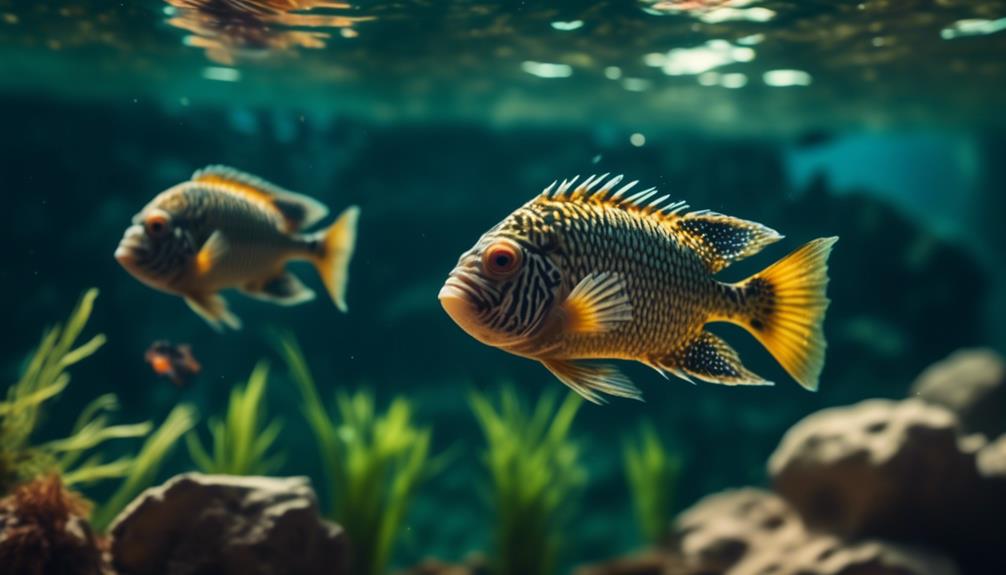
As we shift our focus to the origins and habitat of Tanganyika Cichlids, let’s explore the rich history and diverse environments that have shaped these remarkable fish.
Lake Tanganyika, located in Africa, is the second largest and second deepest body of water in the world. It’s home to at least 250 different species of cichlid and 75 other species.
The lake provides a diverse habitat for cichlids to thrive, resulting in a wide range of colors and patterns in cichlid species.
The water conditions preferred by Lake Tanganyika cichlids include warm, slightly hard, neutral to alkaline water, with an average temperature of about 76F to 78F and a pH range between 7.5 and 9.3.
Thriving in the African Great Lakes
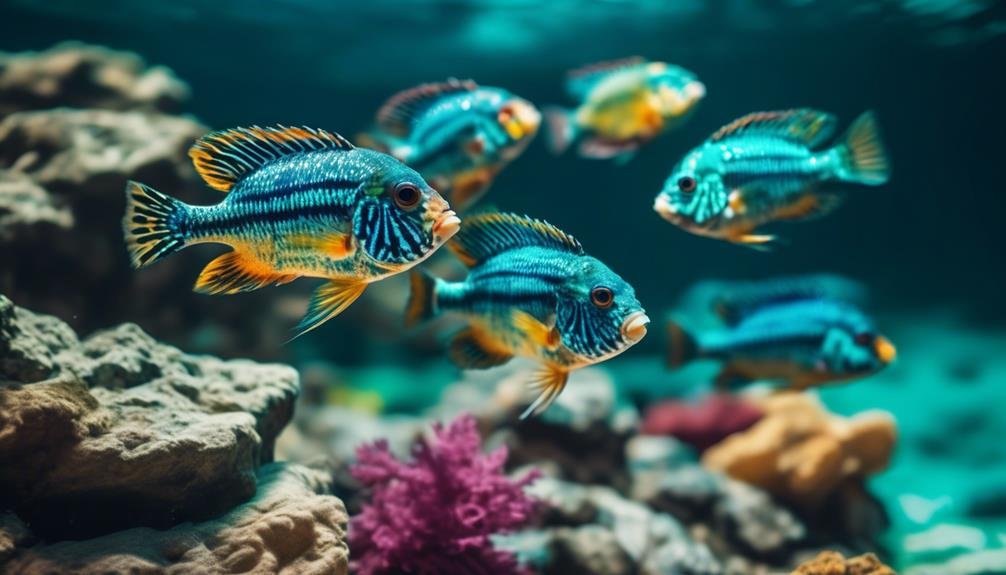
Lake Tanganyika cichlids thrive in the diverse and vibrant ecosystems of the African Great Lakes. These lakes provide the perfect habitat for these colorful fish to flourish.
Lake Tanganyika, the second largest and second deepest lake in the world, is home to at least 250 different species of cichlids and 75 other species. The lake’s warm, slightly hard, neutral to alkaline water conditions favor the cichlids’ survival.
With an average water temperature of 76F to 78F and a pH range between 7.5 and 9.3, these cichlids find the perfect environment to grow and breed.
The lake’s rich biodiversity and abundance of food sources, such as algae, plant matter, insects, and crustaceans, ensure that Lake Tanganyika cichlids can thrive and display their beautiful colors and patterns.
Creating the Perfect Tank for Tanganyika Cichlids
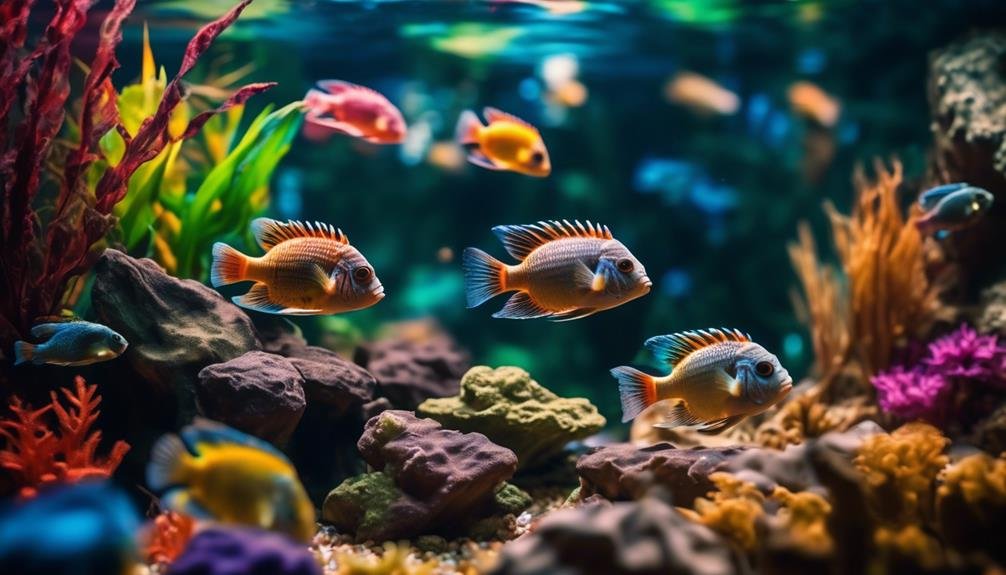
To create the perfect tank for Lake Tanganyika cichlids, consider their unique needs and preferences. These cichlids are endemic to Lake Tanganyika in Africa and thrive in warm, slightly hard, neutral to alkaline water. The tank should have a sand substrate, rocks, and cave formations to provide hiding places for the cichlids. To emphasize the importance of water conditions and tank setup, here is a table:
| Water Conditions | Tank Setup |
|---|---|
| Warm temperature (76F – 78F) | Sand substrate |
| Slightly hard water (10 – 12 dH) | Rocks |
| Neutral to alkaline pH (7.5 – 9.3) | Cave formations |
In addition to their environment, Lake Tanganyika cichlids require a varied diet consisting of high-quality commercial flakes, pellets, and granules, as well as fresh and frozen foods like earthworms and bloodworms. By creating a tank that meets their specific needs, you can provide a thriving and colorful habitat for these fascinating cichlids.
Maintaining Optimal Water Conditions
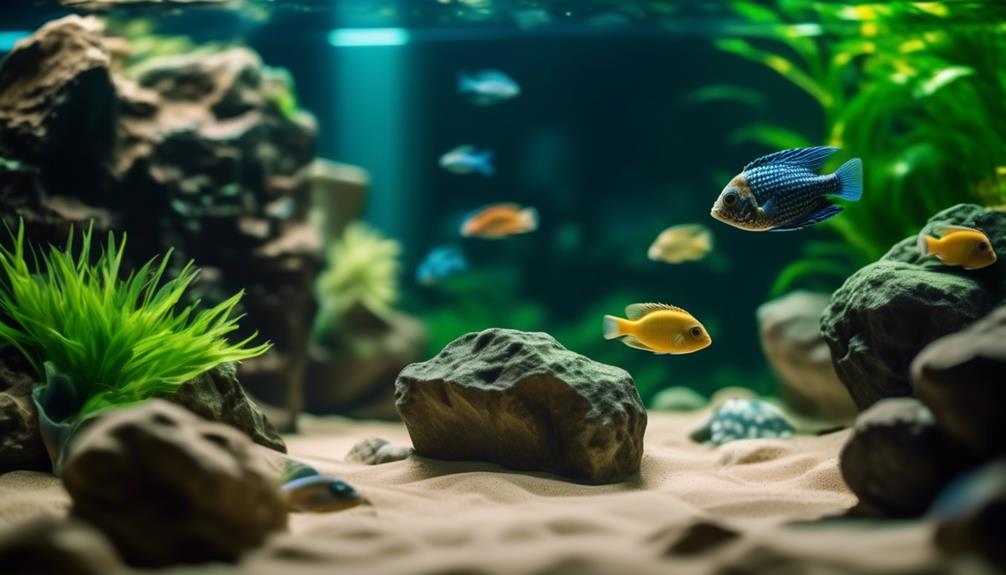
To ensure the health and well-being of your Lake Tanganyika cichlids, it’s crucial to maintain optimal water conditions in their aquarium.
These cichlids prefer warm, slightly hard, neutral to alkaline water. The average water temperature in Lake Tanganyika is about 76F to 78F, with a water hardness between 10 and 12 dH. The pH range for the lake is generally between 7.5 and 9.3.
To recreate these conditions in your tank, make sure to monitor and adjust the temperature, hardness, and pH levels regularly.
Additionally, provide a sand substrate, rocks, and cave formations for hiding places.
Feeding Strategies for Healthy Cichlids
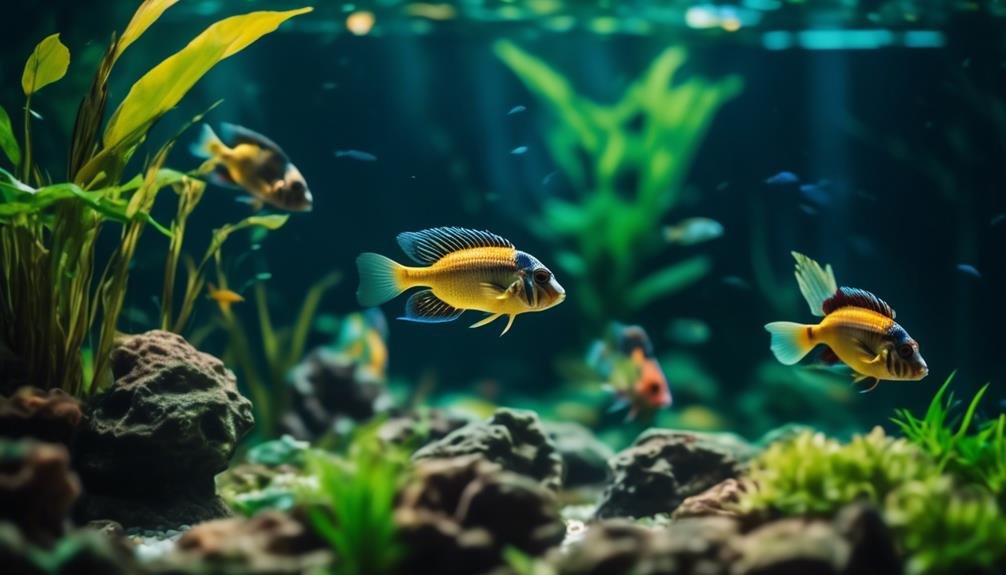
Maintaining optimal water conditions is essential for the health and well-being of your Lake Tanganyika cichlids.
Now let’s focus on the feeding strategies that will ensure their overall health and vitality.
Lake Tanganyika cichlids are largely omnivorous, feeding on algae, plant matter, insects, and crustaceans in the wild.
To provide a balanced diet in the home aquarium, offer high-quality commercial flakes, pellets, and granules.
It’s also important to provide fresh and frozen foods such as earthworms, brine shrimp, and bloodworms. A varied diet is crucial for their overall health and well-being.
Observing their feeding behavior can help you determine the most suitable food options.
Remember to feed them in small portions multiple times a day to prevent overfeeding and maintain water quality.
Breeding Habits and Parental Care
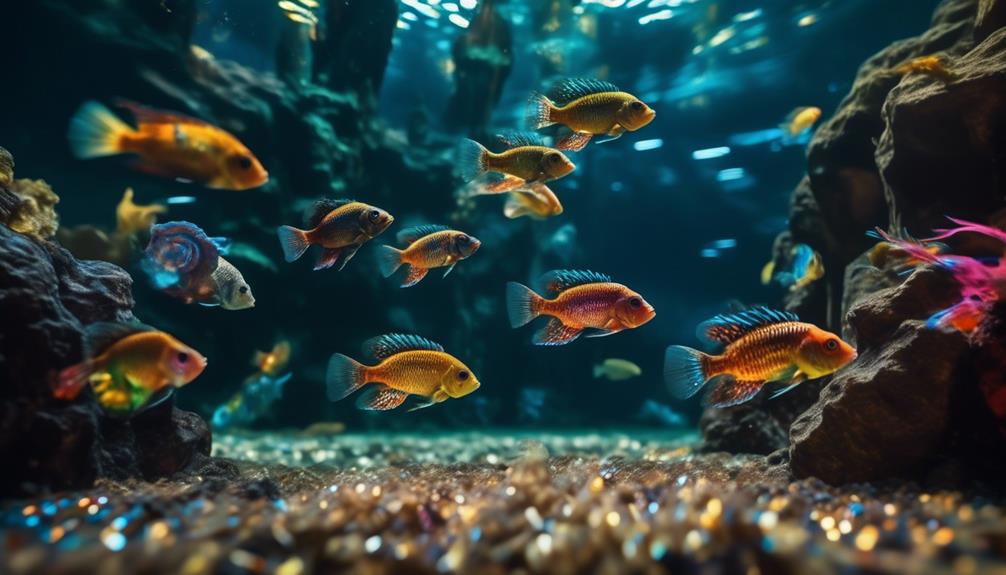
Lake Tanganyika cichlids exhibit a diverse range of breeding habits and provide parental care to their offspring. This makes them fascinating creatures to observe and study. Here are three reasons why their breeding habits and parental care will leave you in awe:
- They display complex courtship rituals, including vibrant color displays, dances, and even aggression towards potential mates, showing their dedication to finding the perfect partner.
- Once the eggs are fertilized, some species of Lake Tanganyika cichlids engage in mouthbrooding, where the female carries the eggs or fry in her mouth for protection, ensuring the survival of the next generation.
- Parental care continues even after hatching, with both parents actively guarding their fry and teaching them essential survival skills, such as foraging and avoiding predators.
The breeding habits and parental care of Lake Tanganyika cichlids highlight their remarkable commitment to ensuring the survival and success of their offspring.
Unveiling the Colorful World of Tanganyika Cichlids
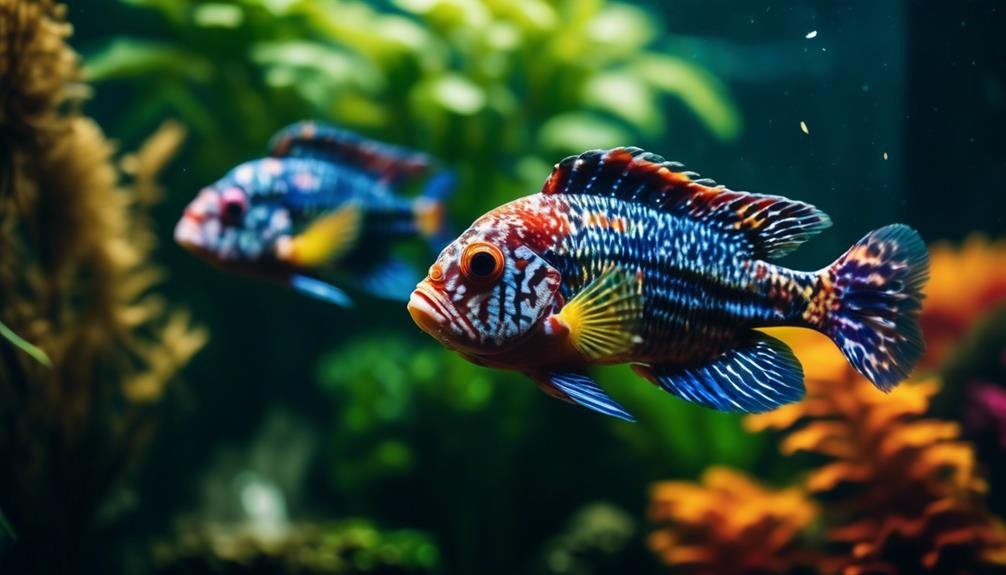
Their remarkable commitment to ensuring the survival and success of their offspring is evident in the vibrant and diverse colors displayed by Lake Tanganyika cichlids. These stunning fish showcase a wide range of hues, from bold blues and fiery reds to vibrant yellows and striking oranges. Each species possesses its own unique coloration and pattern, making them a true spectacle to behold in the aquarium.
Whether it’s the electric blue of the Tropheus genus or the intricate markings of the Neolamprologus species, Tanganyika cichlids never fail to captivate with their kaleidoscope of colors. These brilliant hues not only serve as a visual delight but also play a crucial role in mating rituals and territorial displays, establishing these fish as some of the most colorful creatures in the underwater world.
Frequently Asked Questions
What Is the Average Lifespan of Lake Tanganyika Cichlids?
The average lifespan of Lake Tanganyika cichlids varies depending on the species, but most live for about 8 to 10 years in the wild. Proper care and a suitable environment can help extend their lifespan in captivity.
Are Lake Tanganyika Cichlids Suitable for Beginner Fishkeepers?
Lake Tanganyika cichlids may not be suitable for beginner fishkeepers due to their aggressive nature and specific tank requirements. However, with proper research and experience, you can successfully care for these colorful and fascinating fish.
Can Lake Tanganyika Cichlids Be Kept With Other Fish Species?
Yes, Lake Tanganyika cichlids can be kept with other fish species, but it is important to choose compatible tankmates. Research their specific needs and temperaments to ensure a harmonious tank environment.
How Many Species of Lake Tanganyika Cichlids Are Currently Known to Science?
Currently, science has identified at least 250 different species of Lake Tanganyika cichlids. These colorful fish offer a diverse and vibrant world to explore in the depths of the lake.
Do Lake Tanganyika Cichlids Require a Specific Lighting Setup in Their Tank?
No, Lake Tanganyika cichlids don’t require a specific lighting setup in their tank. As long as you provide them with a natural day-night cycle, they will be happy and thrive in their environment.
Are Lake Victoria Cichlids Similar to Lake Tanganyika Cichlids in Terms of Care and Housing?
Yes, vibrant Lake Victoria cichlids share similarities in care and housing with Lake Tanganyika cichlids. Both require large tanks with rock formations and sandy substrates to mimic their natural habitats. Water quality and temperature are crucial, as well as a varied diet to promote their health and vibrant colors.
Conclusion
So, are you ready to dive into the vibrant and captivating world of Lake Tanganyika cichlids?
These endemic beauties will mesmerize you with their stunning colors and patterns. From the diverse genus of Tropheus to other fascinating species like Goby Cichlids and Neolamprologus, each one has its own unique charm.
With their intriguing behaviors and breeding habits, these cichlids offer a truly captivating experience. Whether you’re a seasoned aquarist or a beginner, exploring the world of Lake Tanganyika cichlids is sure to be a colorful and rewarding journey.




